If you are putting together a workshop or planning a home improvement project, you’ve likely looked at a few different circular saws.
Choosing the best circular saw for your needs is no easy task. Between miter, radial arm, and table saws, the options can be overwhelming.
To make it simpler, here’s a look at two of the best.
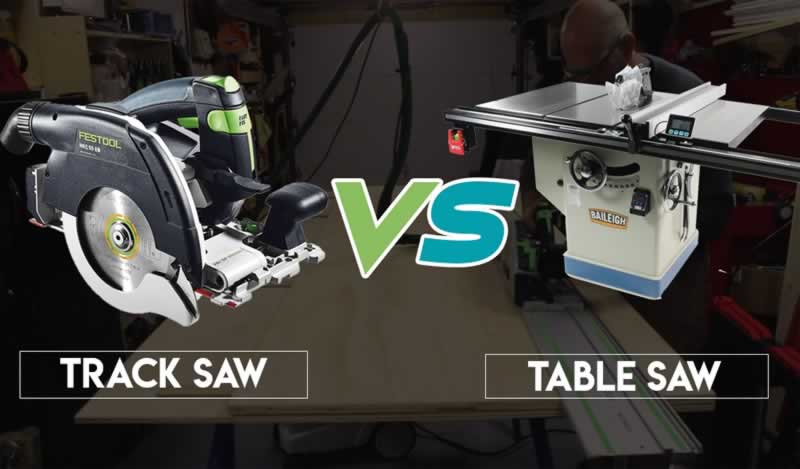
Photo credit: handymantips.org
Track Saw vs Table Saw
Track Saw | Table Saw |
|---|---|
Pros | Pros |
Cons | Cons |
Best for | Best for |
Straight, precise cuts over long distances. This saw makes cutting lengthy lines easy and consistent. | Multiple cuts. This saw is good for making more than one cut of the same dimensions as well as angled cuts. |
What is a Track Saw?
A track saw is a type of handheld electrically powered saw. Like a table saw, it is a circular saw, which means that the blade is circular and operates by spinning rapidly. A track saw is a handheld, meaning that you move it to the wood that is being cut rather than the wood being pushed through the saw blade to cut.
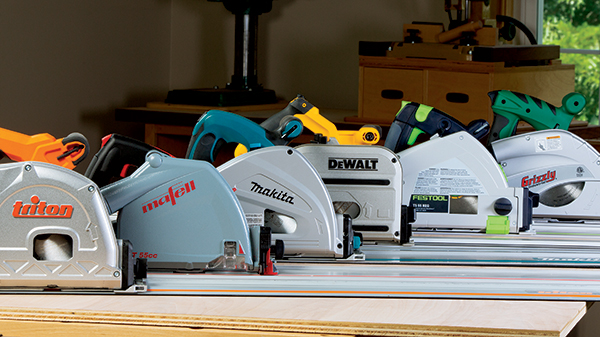
Photo credit: woodworkersjournal.com
The most distinctive feature of a track saw is that it fits onto a sliding guide rail. This guide rail extends in front of the saw and guides the cut to ensure a straight line over long distances. The length of the rail itself determines how long the cut can be.
You can adjust the track saw’s blade height so that the blade extends a certain distance below the rail. This positioning ensures a consistent depth of cut for the entire duration of use and is important both for safety and practical construction reasons. For instance, a track saw can either split a piece of wood entirely or simply cut a groove or divet into the face of the board.
What is a Table Saw?
A table saw is a power tool featuring a circular saw blade that cuts along a horizontal line. On a table saw, the blade remains stationary, and you must pass the material across the blade to cut it. Generally, table saws feature a built-in table surface.
People often use table saws in woodworking, carpentry, and hobby jobs, but these saws are regularly used for a wide range of industrial, construction, and household tasks. Many amateur handymen or homemakers use these tools when performing home improvement tasks.
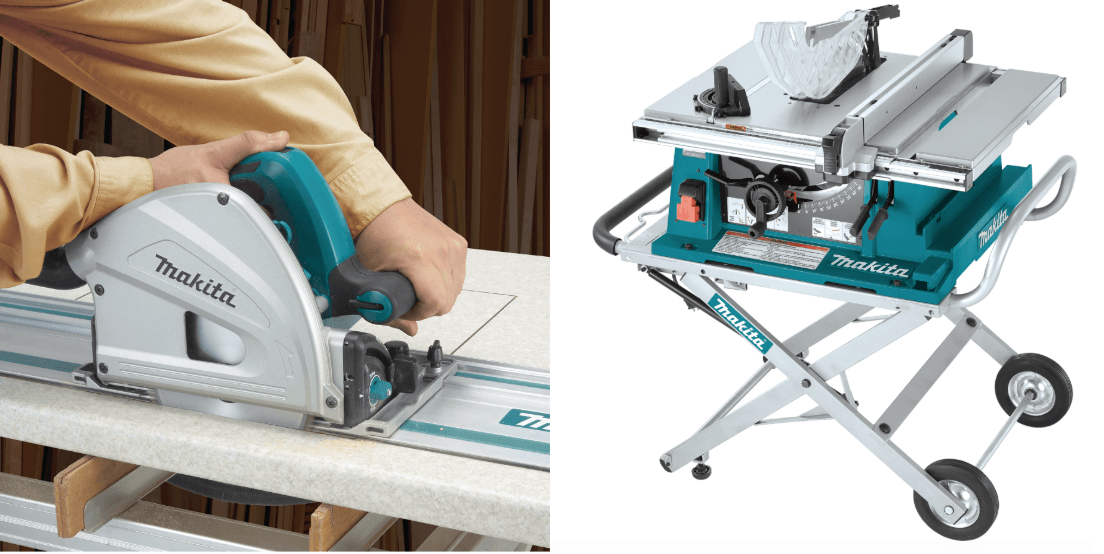
Photo credit: tooltally.com
There is a range of different table saws available. Most table saws usually feature a circular saw, an arbor, a table, a fence, and an electrical motor. Some table saws also feature additional components such as feather boards, miter gauges, and push sticks. Also, you can add different blades to cut various materials.
Some of the aspects to look out for when buying a table saw are rip capacity, the adjustability of its fence, whether or not it features a miter gauge, the motor power, the potential RPMs its blade can reach, and the potential depth of its cut. These aspects make the difference between a top tier and lower level saw.
Relevant Characteristics Between Track Saws and Table Saws
Track Saw | Table Saw | ||
|---|---|---|---|
Average 1,200W | Wattage | 600-2,400W | |
1,750+ (High max range) | RPM | 3,450+ (High max range) | |
100”+ | Length of Cut | Max ~4’x8’ | |
Varies by adjustment | Depth of Cut | ~3-4” depth on 10-12” Blade | |
Typically 9-13 | Amperage | Typically 15 | |
Similarities and Differences
As you can likely tell, there are actually many similarities between track and table saws. For instance, both feature circular saw blades and tend to cut straight lines. However, when we get into the heart of it, these two saws are quite different. Here’s a look at both:
Track Saw and Table Saw Differences
At first glance, the main difference between a track saw and a table saw is fairly obvious. A track saw features a long guide rail that extends in front of the saw. In contrast, a table saw is positioned on a table. Unless the table saw is a benchtop saw, the saw likely has a table attached to the saw itself, which makes the table saw a much larger and more permanent fixture.
Another major difference is obvious as soon as you start to use the saw. A track saw functions by moving the saw, and the saw blade, towards the material you're cutting. A table saw has a stationary blade that cuts when you move the material toward it. These differences allow each tool to perform a different job.
Most often, people use track saws to make long and straight cuts. The guide rail can be positioned across the entire length of a board or plank, ensuring that the cut does not waver. On a table saw, the fence guides the material through the saw blade. This setup keeps cuts smooth and consistent, and since the blade itself remains stationary, how steady you push the material determines much of the cut.
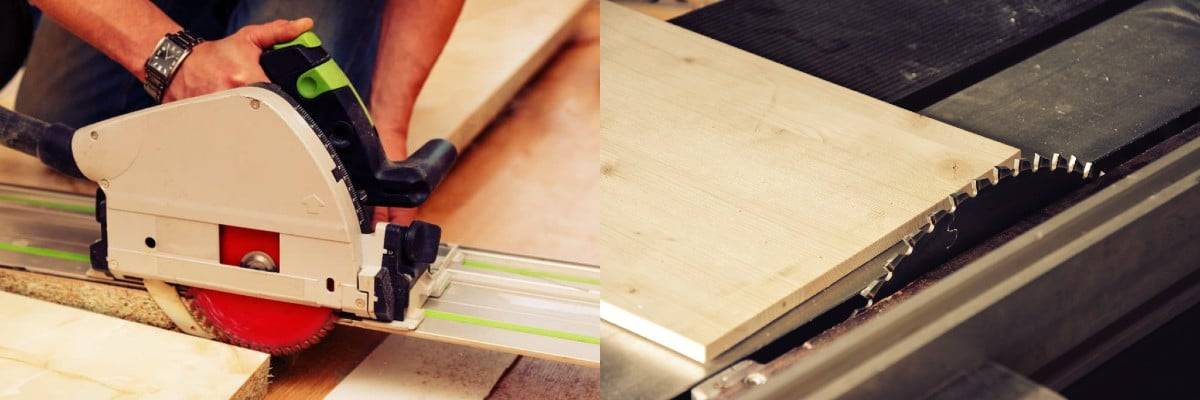
Photo credit: woodsmithspirit.com
A table saw can perform angled cuts through the use of a miter gauge. This gauge is very handy and allows you to make a range of different cuts. In contrast, a track saw can perform beveled cuts because you can position the blade at an angle. Often, the rail supports a 45-degree angle or a 90-degree angle.
Another difference between the two saws relates to the blade position. On a track saw, the blade cuts from the top of the material. By adjusting the depth of the blade, you adapt the depth of the cut. On a table saw, the blade extends up from the table, which means that the cut comes from beneath.
Track Saw and Table Saw Similarities
As the variables identified above indicate, there are many similarities between table saws and track saws because both saws are different kinds of circular saws.
Though many table saws are larger and tend to be more powerful, the basic mechanism in these saws is often the same. They both rely upon a circular spinning blade, an electric motor, and an arbor. Often, they use gears or belts to assist the spin. The internal mechanism on these saws is often nearly identical.
A table saw relies upon its fence and miter gauge to ensure consistency. A track saw relies upon its guide rail to do so. However, for most practical purposes, the result is very similar. Both table saws and track saws are renowned for their use in smooth, lengthy cuts. Simply because the track saw tends to get more praise when it comes to these cuts should not be taken as an indication of a table saw’s weakness. In comparison to other circular saws, table saws perform long, straight cuts incredibly well.
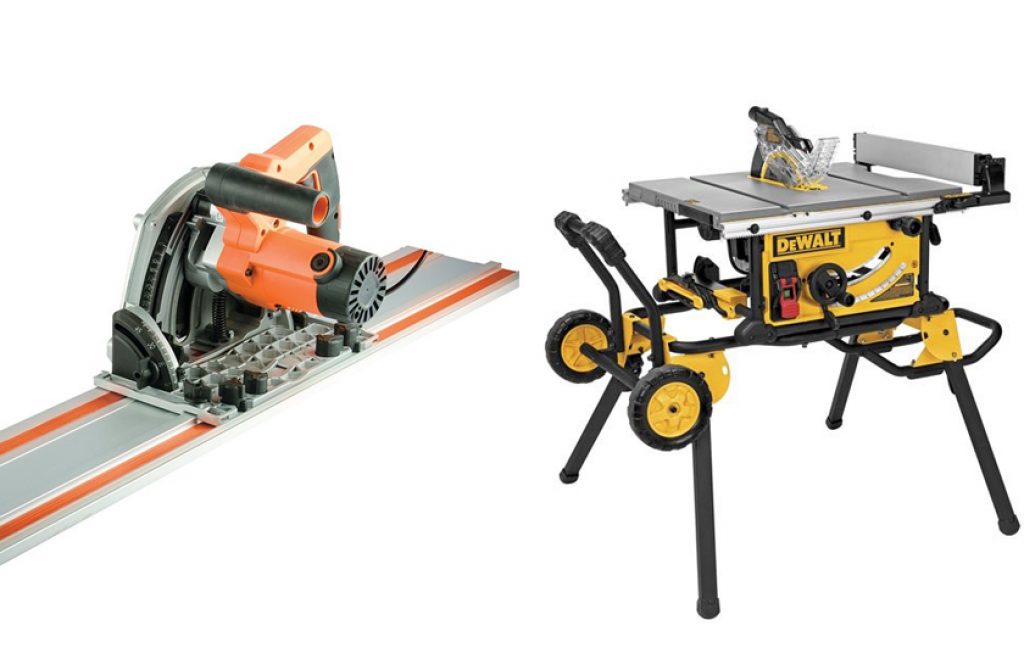
Photo credit: picktoptools.com
Table saws and track saws are also both multi-purpose woodworking tools. People use table saws and track saws for a wide variety of tasks, including ripping, crosscutting, beveling, or trimming materials. You can also use both saws to cut materials other than wood, such as tile or aluminum.
Some people chalk the differences between table saws and track saws up to power, size, and portability. While this is not an entirely accurate assessment, it does attest to the similarity between the two products. These saws are both great woodworking tools. They make difficult tasks far easier than they once were by applying electrical power to a spinning blade, which allows for more cuts, better cuts, and faster cuts.
Advantages of Track Saws
The major advantage of the track saw is its guide rail. The saw runs along this rail when in use, cutting the material in question and keeping the cut consistent and smooth for the entire length. Also, the operator can adjust the depth of the cut. The distance that the blade extends beneath the rail corresponds to the cut depth, which allows for significantly more control over the type of cuts the saw can do.
You can use a track saw to cut pieces out from the middle of the board, which can be useful when attempting to make a cutout or when you require a single piece without a seam.
By performing a plunge cut by dropping the blade’s height while it is over the board, you can make the cutout without an entry or exit mark. This approach prevents the exterior piece from being marred.
Track saws also tend to be more lightweight and portable than table saws because the saw only requires a single-track rail, which is generally light, to function. In contrast, a table saw requires a full table surface or stand to operate. Track saws to be moved easily between workspaces, job sites, and materials.
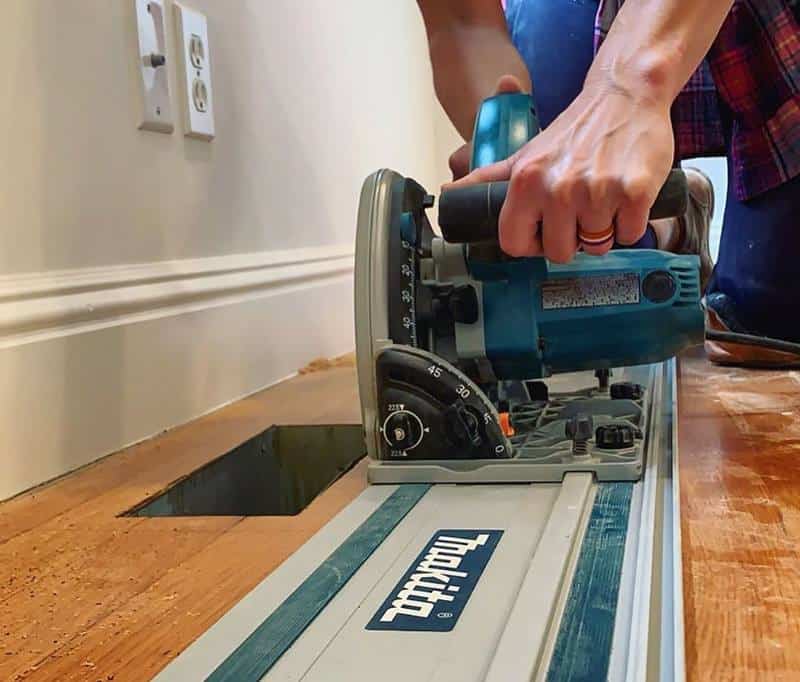
Photo credit: toolshaven.com
Like a table saw, you can use a track saw to cut a wide range of materials, though you will need to switch the blade. As a track saw keeps a consistent rail guide, cutting something like aluminum is much easier than on a table saw. When cutting aluminum on a table saw, the slightest miscalculation can cause a knick, torque, or waver. When assembling an air duct, for example, this could cause serious issues or leaks.
Advantages of Table Saws
Table saws are incredibly versatile. They are one of the most popular and common pieces of equipment across the country. A table saw is most often used for ripping planks, cutting sheets, or for making any large scale straight cuts. These saws are generally used to cut wood; however, they can also cut plastic, acrylic, tile, or metal with the correct blades.
The specific features and variables you require in your table saw will depend on how you are most likely to use it. For instance, if you tend to use your table saw to make small, precise cuts or angles, you will need a table saw with an adjustable fence and a miter gauge. As a result, you will likely have to buy a higher quality saw.
Track saws are great for making multiple cuts of the same dimensions.
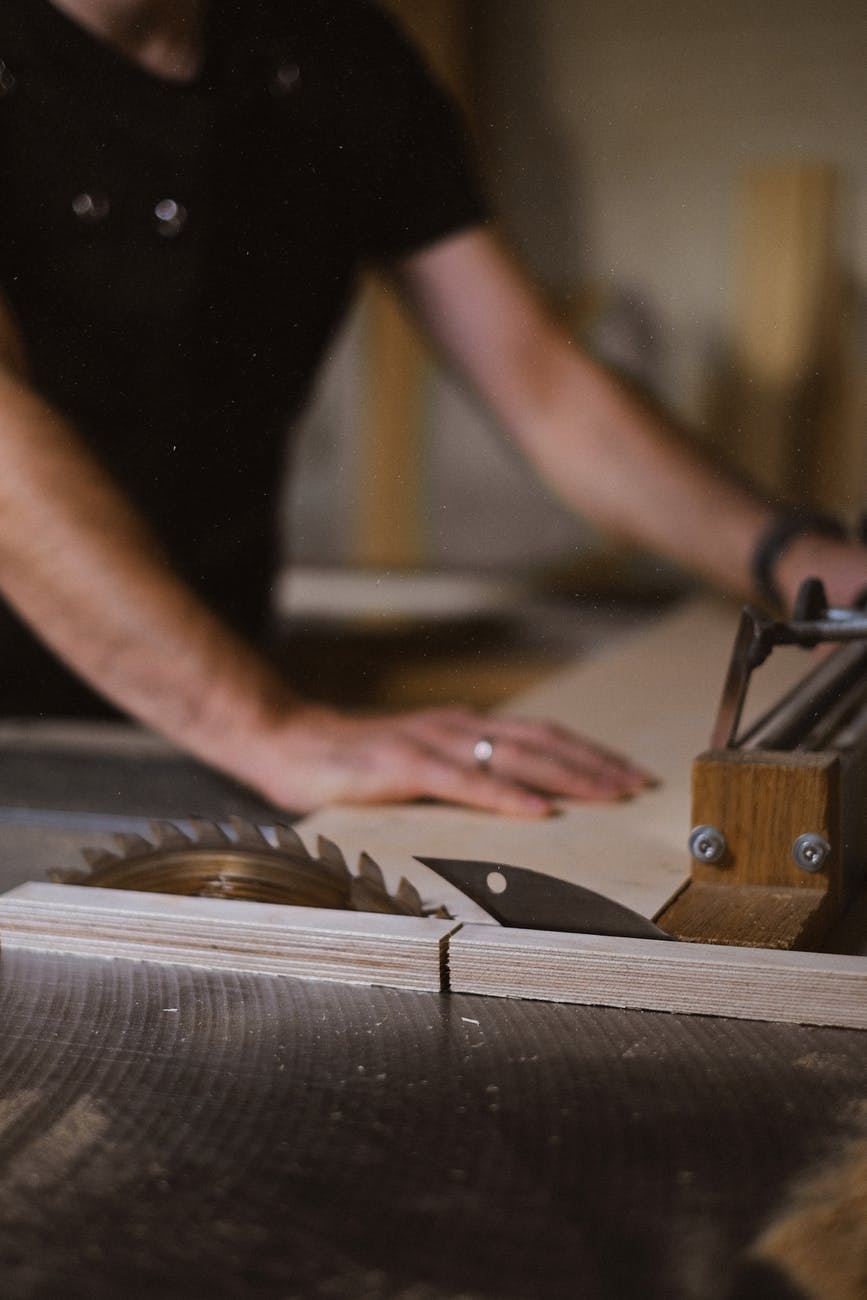
As the table calibrates the cut, you need to pass the material through the table without altering the fence and miter gauge to ensure that the cuts are equivalent. In contrast, a track saw requires calibrating the measurement to each piece of material.
A table saw is also much easier to use than a track saw because you only need to push the material into the saw blade. While this means that you must move the material steadily and consistently, it requires minimal effort. If you are making an angled cut, a table saw will direct the material through the blade.
Also, a table saw can remain set up. If you are working on a project over multiple days or sessions, you can leave the table in position while you are not working. In contrast, you must set up a track saw every time you want to use it.
What About Circular Saws?
Track saws and table saws are both circular saws. You can tell by the mechanisms they use when cutting and the spinning saw blade. Other common forms of circular saws are table saws, track saws, miter saws, brush cutters, radial arm saws, abrasive saws, panel saws, track saws, pendulum saws, biscuit joiners, and sawmill saws.
When most people use the term circular saw, however, they are typically referring to a handheld circular saw, which is a circular saw without a track, table, or stand. A circular hand saw is handy because it is portable, quick to use, and very compact. In essence, circular hand saws are powered replacements for standard hand saws, and anyone who has spent a lot of time ripping pieces of wood is likely familiar with the necessity for this innovation. With a crosscut or rip saw, a project of any size can be slow and tedious work.
As circular hand saws replace regular hand saws, they are likely to be used more often than a table or track saw. Like other circular saws, you can fit handheld saws with special blades to cut materials besides wood. Though this is possible, it is not quite as common as it is on a table, miter, or track saws because cutting a synthetic or metal material likely requires more precision and accuracy.
You're likely to use a handheld circular saw for smaller jobs, like crosscutting or ripping individual planks of wood or to trim extra length from the material. While handheld saws can, technically, perform most of the cuts that a table or track saw can, they require much more dexterity and operator expertise to do so.
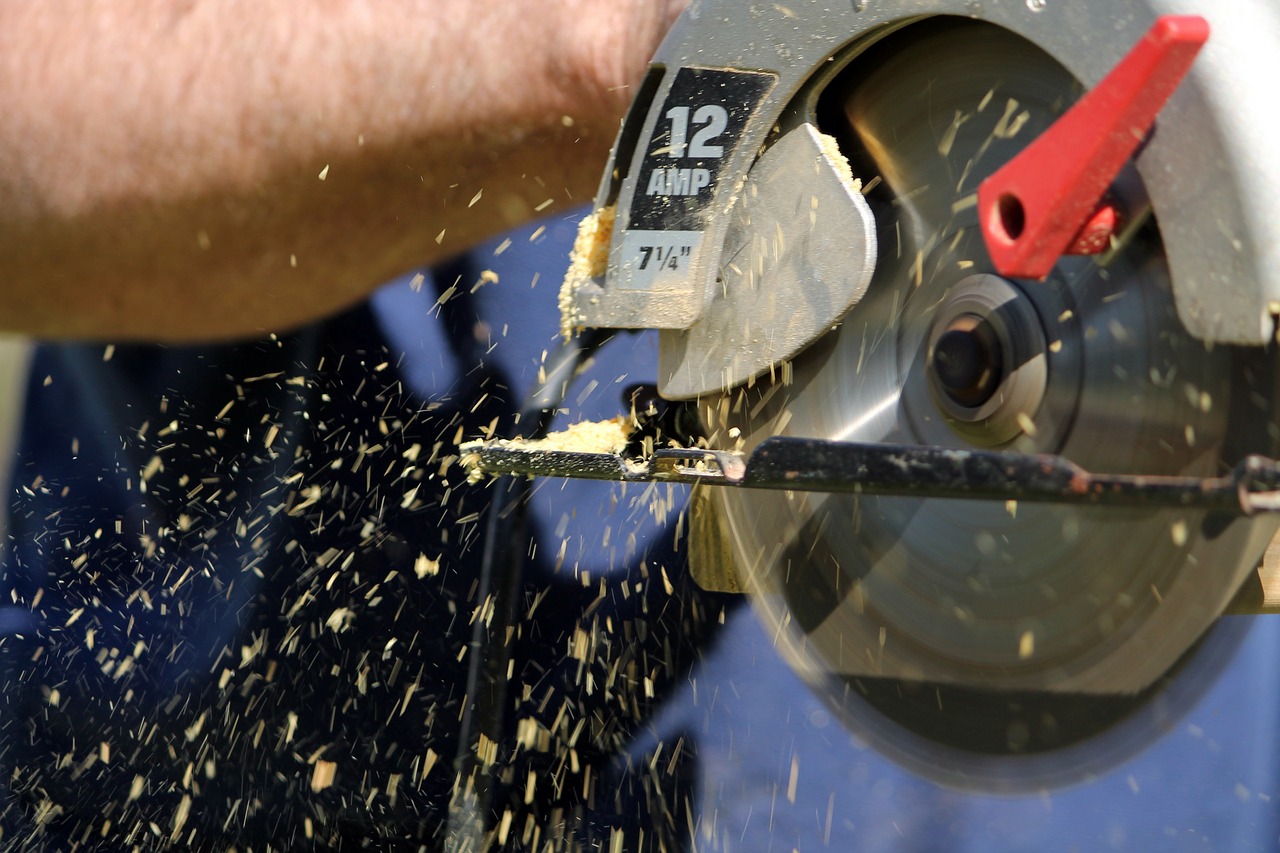
When and Why Would I Use a Track Saw?
People use table saws for a wide range of tasks. A table saw is likely one of the most versatile types of saws available. Generally, people use a table saw when they are working with wood. Using specialized blades, a table saw can also cut many other materials, including metals, synthetics, tiles, and acrylics.
You might need a table saw on a construction site, a home improvement project, or hobby work. If you need to cut wood to build a deck, a porch, or a door, for instance, you will likely need to use a table saw in the process.
Here are some of the things that a track saw does best:
Long, Straight Lines
The guide rail on a track saw means that the line cut will be perfectly straight every time. The length of the cut only depends on the length of the rail. On a table saw, the length is determined by table surface size.
Clean and Smooth Cuts
A track saw allows you to push the blade through the material being cut. This keeps pressure consistent and steady, producing even cuts.
Cutting Internal Lines
Because a track saw is highly maneuverable, you can use them to descend on a board internally, removing a piece without the need for entry or exit marks. This is not possible on a table saw.
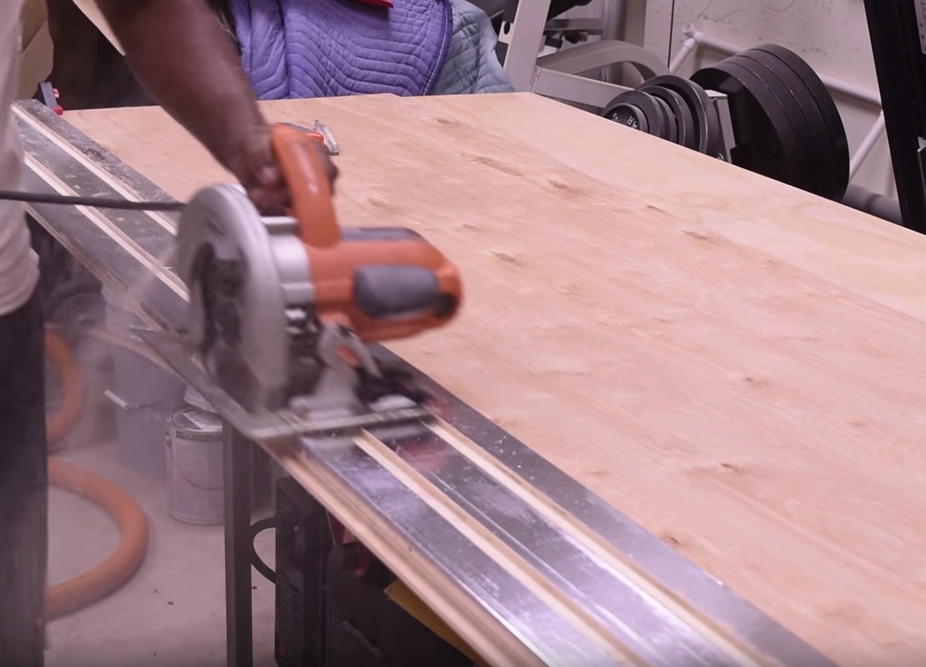
Photo credit: popularmechanics.com
When and Why Would I Use a Table Saw?
Table saws are used for a huge range of tasks. A table saw is likely one of the most versatile types of saws available. Generally, people use a table saw when they are working with wood. With specialized blades, a table saw can also cut many other materials, including metals, synthetics, tiles, and acrylics.
You might need a table saw on a construction site, for a home improvement project, or hobby work. If you need to cut wood to build a deck, a porch, or a door, for instance, you will likely need to use a table saw in the process.
Here are some of the things that table saws do best:
Large Cuts
Whether you’re ripping a long piece of plywood, or cutting through a thick piece of lumber, a table saw is the best tool for large cuts.
Repetitive Cuts
A table saw allows you to make consistent cuts of the same dimensions multiple times with very little effort. If you’re cutting a large number of planks, it is the easiest tool.
Versatility
In the hands of a talented craftsman, a table saw can make just about any kind of cut. You can cut angles, miters, and trims.
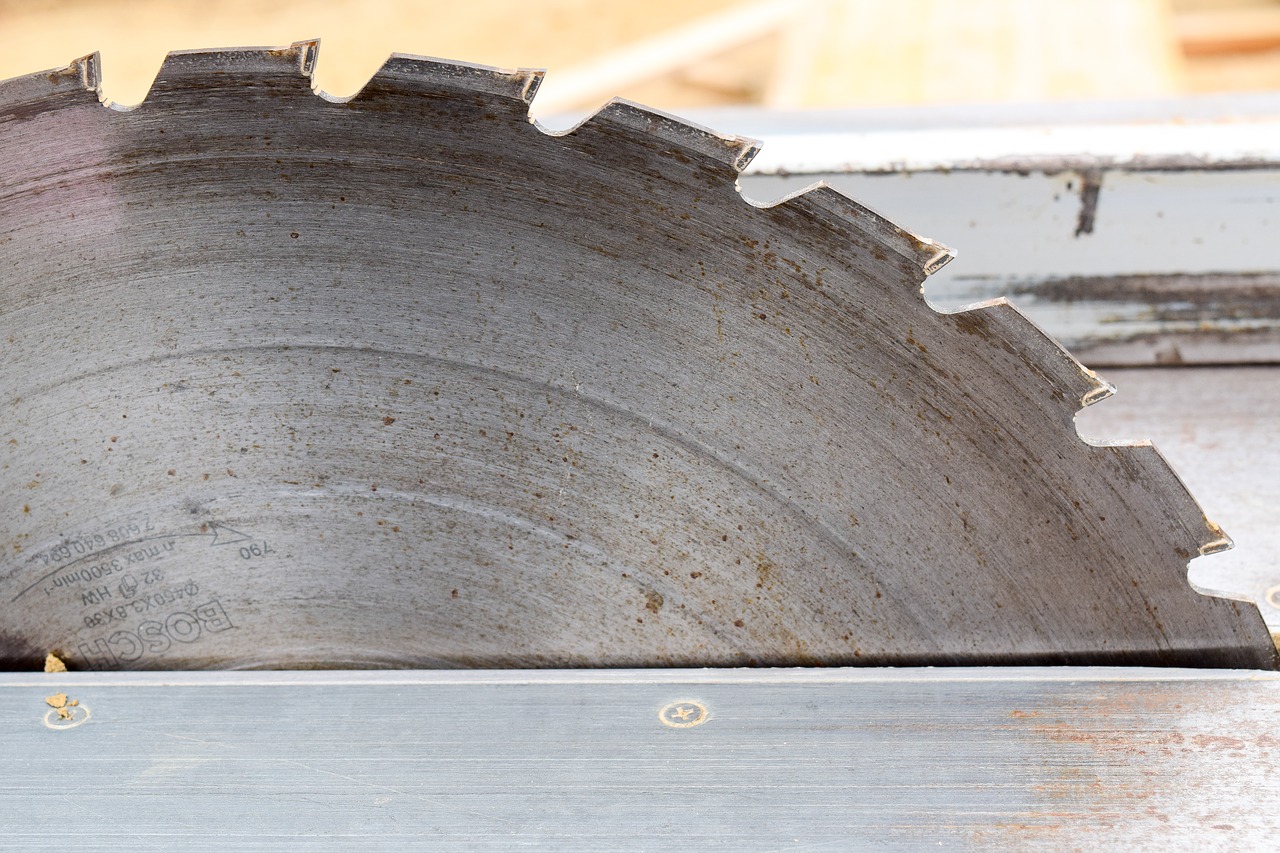
Bottom Line
Table saws and track saws are both great tools for the jobs that they handle. When it comes down to it, we can’t replace one entirely with the other. While a track saw can make long and consistent cuts like a table saw, it cannot easily cut narrow boards and takes more effort when cutting.
A table saw is generally best when cutting multiple planks, performing a wide variety of jobs, or attempting to cut angles. The setup makes these functions far easier than they are with a track saw.
A track saw is best used when making long and consistent cuts. They can also cut internal pieces quite easily.
People Also Ask
By now, you probably feel like a bit of an expert on circular saws. Before closing shop, we have a quick FAQ guide to answer any questions we left unaddressed. Take a moment to review it before heading out and picking up your newest piece of equipment!
Can a Track Saw Replace a Table Saw?
A track saw can replace a table saw for specific jobs. Track saws can make clean, long cuts. As a result, they can be used for many jobs typically associated with a table saw. A table saw is still better for many jobs, however. It is far better at making rip cuts, for instance.
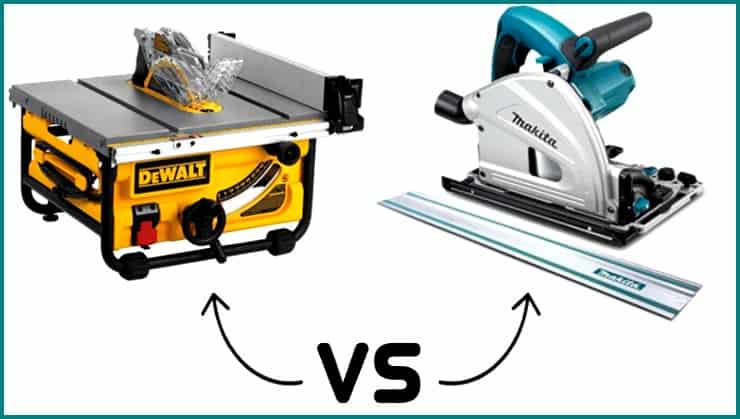
Photo credit: toolshaven.com
Can I Use a Track Saw Without the Track?
Theoretically, you can use a track saw without the track. However, we don't advise it as it will likely be dangerous, ineffective, and may void your warranty. A track saw’s purpose depends on its track. A track saw is not designed for visibility without a track, making accuracy difficult on cuts.
How Much is a Table Saw?
The price of a table saw can vary hugely. It is possible to buy table saws for about $100. These saws are the lowest tier and are unlikely to be particularly effective. It is also possible to buy table saws for anywhere from $2,500 - $5,000. On average, a table saw will run between $250 and $1,500.
How Much is a Track Saw?
Like table saws, track saw prices can vary pretty widely. You can purchase a quality track saw for around $200-$400. However, it is also necessary to buy the track itself. Most of the time, the track is sold separately. A track tends to run somewhere between $50 and $250.
